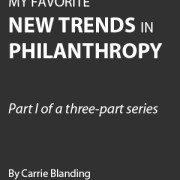My Favorite New Trends in Philanthropy Part I
We’ve all been there: you’re at a conference, or a fund development meeting, or coffee with a colleague, and the conversation turns to What Is Wrong With The Current Funding System. We commiserate about the perils of chasing program funding. We lament the scarcity of general operating support. We share stories of insane reporting requirements. . . .
But lately when these conversations come up I find myself irresistibly bringing up the bright side. Why? Because for the past six months I’ve been reading a lot about philanthropy, and the beautiful truth is that I’m seeing some good ideas out there. Some of them are still just a twinkle in the eye of an academic, but others are starting to take hold and influence the way funding gets distributed.
So let’s take a little break from thinking about what’s not working, and focus on a few encouraging trends in the philanthropic sector. In this three-part series, I’ll write about a few of my favorites: improved assessment tools for donors, smarter thinking about capital, and outcome-oriented philanthropy.
Part 1: Improved Assessment Tools for Donors
Remember when organizational effectiveness was determined by how much a nonprofit spent on overhead? Well ring the bells, because that clumsy old metric is on its way out! The current trend is to look beyond simplistic ratios and empower donors with more well-rounded assessment tools.
The movement away from overhead ratios has been making headlines lately. By now we’ve all seen Dan Pallotta’s TED talk on the subject. Much more exciting, in my opinion, is this open letter denouncing the “overhead myth,” signed by the CEOs of Guidestar, Charity Navigator, and BBB Wisegiving Alliance.
In their words, the letter “marks the beginning of a campaign to correct the common misconception that [overhead] … is, on its own, an appropriate metric to evaluate when assessing a charity’s worthiness and efficiency.”
While the campaign is new, the idea is not. Various foundations, consultants, and information providers have been thinking hard about this issue for some time. That’s good news because it means that several new and improved online assessment tools have already been (or are being) developed.
Perhaps the most accessible of these is Philanthropedia. This site allows anyone to view free ratings of nonprofits based on peer assessments. Developed at the Stanford Graduate School of Business, launched in 2009 with funding from the Hewlett Foundation, and acquired by Guidestar in 2011, this young site is a testament to how the goal of improving donors’ access to information is supported across the philanthropic sector.
The arts are well represented on Philanthropedia, with twenty-one rankings of Bay Area arts nonprofits, and seventeen national rankings. The site only ranks its “top nonprofits,” refraining from singling out any groups as not worthy of support. It does, however, allow users to view the peer comments (both positive and negative) that it receives for non-ranked nonprofits.
Another new offering from Guidestar, with the Nonprofit Finance Fund, is Financial SCAN. Launched in 2012, this tool attempts to evaluate an organization’s financial health over the long term, in a more comprehensive way than ever before. Priced at $2,500 a year, Financial SCAN appears to be primarily intended for large foundations and financial advisers.
Charity Navigator, a ratings site available to the general public, is a bit behind the times but poised to catch up. Currently this site only rates nonprofits on financial health, accountability, and transparency, but they are working towards adding “results reporting” (basically impact measurement) to their evaluation criteria by 2016.
If you’re interested in getting a bigger-picture view of how this trend can improve the nonprofit world, check out this 2008 white paper from the Hewlett Foundation. In the report, the foundation describes its vision for a bustling nonprofit marketplace in which individual donors, empowered with better information, efficiently direct their resources to the best nonprofits. We’re not there yet, but we seem to be moving in the right direction.
Stay tuned for my next installment: an ode to growth capital!
 About Carrie Blanding
About Carrie Blanding
Carrie Blanding is currently on a research sabbatical in which she gets to blissfully romp through the most interesting nonprofit literature every day. She is particularly fascinated by organizational sustainability, personal resilience, effective philanthropy, and management theory.
Previously, she has been executive director of the the San Francisco Contemporary Music Players, and co-founder/principal of Next Big Thing Children’s Theatre. She earned her bachelor’s degree, summa cum laude, in comparative literature from the University of California, Berkeley, and received the department award for academic achievement.
An avid singer, Carrie has at times been a member of the San Francisco Symphony Chorus, a jazz vocalist, and a singer-songwriter pouring her heart out at your neighborhood bar.



